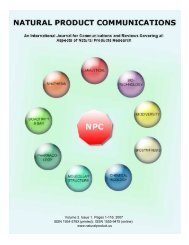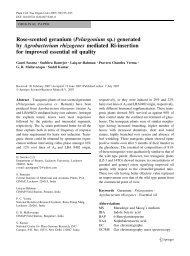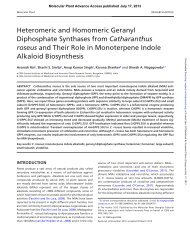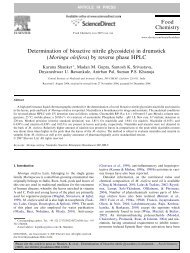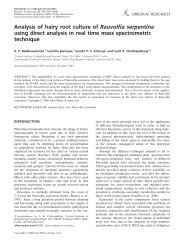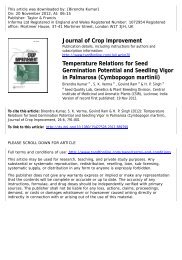Recent advances in plant hepatoprotectives - CIMAP Staff - Central ...
Recent advances in plant hepatoprotectives - CIMAP Staff - Central ...
Recent advances in plant hepatoprotectives - CIMAP Staff - Central ...
Create successful ePaper yourself
Turn your PDF publications into a flip-book with our unique Google optimized e-Paper software.
760<br />
*<br />
NEGI ET AL.<br />
COOH<br />
O<br />
H<br />
COOH<br />
O O<br />
OH<br />
OH<br />
HOOC O<br />
O<br />
OH<br />
OH<br />
OH<br />
15<br />
Figure 11. Structure of glycyrrhiz<strong>in</strong> (15).<br />
The roots are extracted <strong>in</strong> boil<strong>in</strong>g water and on cool<strong>in</strong>g glycyrrhiz<strong>in</strong> get separated <strong>in</strong>to solid<br />
compound. It is found up to 4% <strong>in</strong> the roots. Several analytical methods have been developed to<br />
determ<strong>in</strong>e glycyrrhiz<strong>in</strong> by HPLC 144,145 and HPTLC. 146<br />
C. Biological Activity<br />
Glycyrrhiz<strong>in</strong> prevents several forms of experimental liver <strong>in</strong>jury <strong>in</strong> animals. 147 It has shown<br />
hepatoprotective activity <strong>in</strong> animal models aga<strong>in</strong>st carbon tetrachloride <strong>in</strong>duced toxicity and<br />
hepatitis. 148 One of Japanese formulations of glycyrrhiz<strong>in</strong>, known as stronger neom<strong>in</strong>ophagen C<br />
(SNMC), comb<strong>in</strong>ed with, 0.1% cyste<strong>in</strong>e, and 2% glyc<strong>in</strong>e has been used for the treatment of chronic<br />
liver diseases. Different experiments conducted on SNMC showed its efficacy <strong>in</strong> the treatment of<br />
subacute hepatic failure, chronic hepatitis C, 149 and cirrhosis. However, the effect of glycyrrhiz<strong>in</strong><br />
aga<strong>in</strong>st the chronic hepatitis B was found to be very poor. 150<br />
Intravenously adm<strong>in</strong>istered glycyrrhiz<strong>in</strong> is metabolized <strong>in</strong> the liver by lysosomal b-Dglucuronidase<br />
<strong>in</strong>to 3-mono-glucuronide glycyrrhet<strong>in</strong>ic acid and then excreted with bile <strong>in</strong>to the<br />
<strong>in</strong>test<strong>in</strong>e. It is further metabolized by <strong>in</strong>test<strong>in</strong>al bacteria <strong>in</strong>to glycyrrhet<strong>in</strong>ic acid, which can be<br />
reabsorbed here (Fig. 12). 151<br />
COOH<br />
O O<br />
OH<br />
OH<br />
HOOC O<br />
O<br />
OH<br />
OH<br />
OH<br />
a<br />
O<br />
H<br />
COOH<br />
1<br />
COOH<br />
O O<br />
OH<br />
OH<br />
OH<br />
O<br />
b<br />
H<br />
COOH<br />
2<br />
HO<br />
O<br />
c<br />
H<br />
COOH<br />
Figure 12. Metabolism of glycyrrhiz<strong>in</strong> after <strong>in</strong>travenous adm<strong>in</strong>istration: (1) by lysosomal b-D-glucuronidase <strong>in</strong> the liver, and<br />
(2) by bacteria b-D-glucuronidase <strong>in</strong> the <strong>in</strong>test<strong>in</strong>e. a. Glycyrrhiz<strong>in</strong> (b) 18b-glycyrrhet<strong>in</strong>ic acid mono-b-D-glucuronide (c) 18bglycyrrhet<strong>in</strong>ic<br />
acid.<br />
Medic<strong>in</strong>al Research Reviews DOI 10.1002/med




